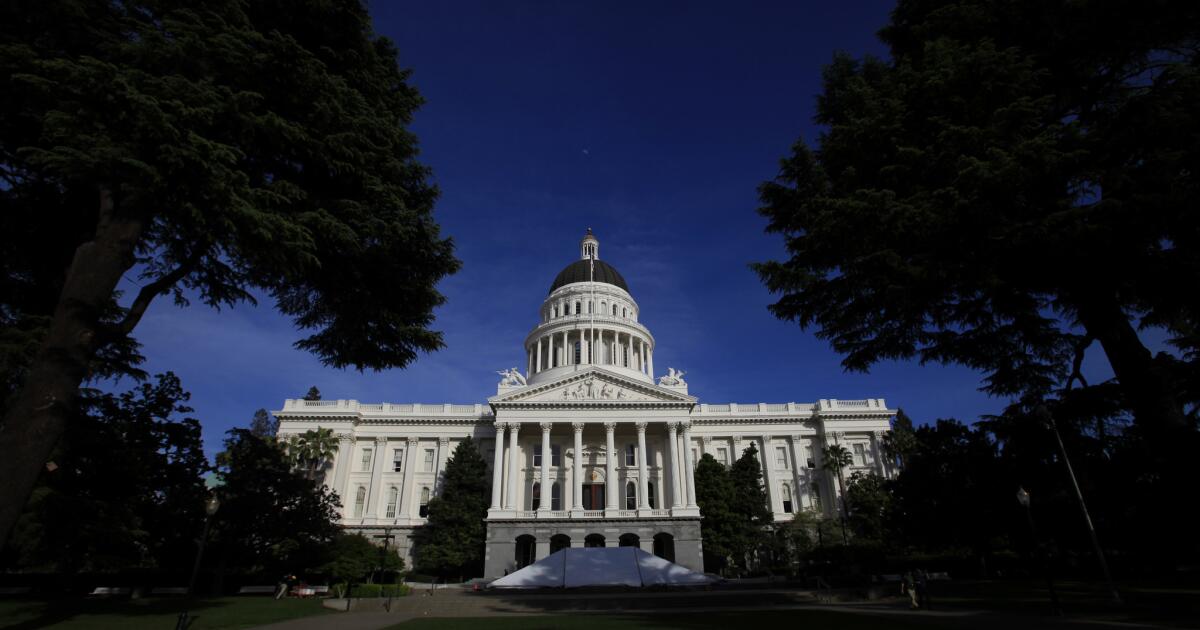
People live longer in blue states than red; new study points to impact of state policies
A new study traces how the policies adopted by Democratic and Republican states over the last several decades have helped widen the gap in life expectancy.
People live longer in blue states than red; new study points to impact of state policies

States such as California that have pursued more liberal policies in education, environment and civil rights have seen a swifter rise in life expectancy than more conservative states. Above, the California Capitol in Sacramento.
(Los Angeles Times)
BY NOAM N. LEVEY
AUG. 3, 2020 9:01 PM PT
WASHINGTON —
Weak environmental protections, safety rules and labor and civil rights protections may be cutting lives short in conservative states and deepening the divide between red and blue states, according to a new study on links between life expectancy and state policy.
The report, published Tuesday in the health policy journal Milbank Quarterly, finds that states where residents live longest, including California, tend to have much more stringent environmental laws, tougher tobacco and firearms regulations and more protections for workers, minorities and LGBTQ residents.
Since the mid-1980s, the gap among U.S. states in how long their residents live has widened, reversing decades of progress toward greater equality.
One group of states, mostly in the Northeast and the West, have seen average life expectancies rise relatively steadily, placing them on par with the wealthiest nations of Western Europe. Those states tend to have more stringent regulations.
By contrast, the life expectancy in states with more conservative health, labor and social policies — concentrated in the South and Appalachia — have stagnated in recent decades, according to the study, which adds to growing research on health and political disparities between states.
California has among the highest average life expectancies in the country, at 81.3 years. It also had the most liberal policies in the nation in 2014, the most recent year the study analyzed, according to the system the authors developed to rank states.
Although the study’s authors note that they can’t prove that state policies caused the gap in life expectancy, the correlation is a persistent one across multiple states and several decades.
“It’s disheartening to see another example of a missed opportunity by policymakers,” said David Radley, senior scientist at the nonprofit Commonwealth Fund who studies differences in state health policies and the effects on people’s health. Radley was not involved in Milbank report.

The new report may help shape efforts to rethink government policy in the wake of the coronavirus pandemic, which has exposed deep structural weaknesses in the U.S. as well as yawning gaps in many state safety nets.
“The overarching conclusion is clear: States that have invested in their populations’ social and economic well-being by enacting more liberal policies over time tend to be the same states that have made considerable gains in life expectancy,” the study’s authors wrote.
Even before the current public health crisis, life expectancy in the U.S. had been declining, setting America apart from most other wealthy nations. That decline has fueled tough questions about domestic policy.
The opioid epidemic, which has had a devastating impact on regions of the country already hit hard by economic stagnation, has been the focus of a lot of the discussion about that shift.
But Syracuse University sociologist Jennifer Karas Montez, the lead author of the new study, said the impact of opioids may be only part of the story.
“When we look at what is happening with life expectancy, the tendency is to focus on individual explanations about what Americans are doing,” she said, noting obesity and smoking behaviors as well as drug use. “But state policies are so important.”
To assess what role these policies may be playing, Montez and other researchers reviewed more than 120 policies enacted by states over the years and assessed whether each policy choice in each state was more liberal or more conservative.
Policies included housing rules such as rent control; health and welfare policies such as Medicaid eligibility and welfare limits; labor protections such as paid sick leave and minimum wages; and civil rights policies such as gender discrimination bans, hate-crime laws and same-sex marriage.
They also looked at state abortion restrictions, tax policy, education spending, immigration rules and gun control laws.
Each state was ranked by how liberal or conservative its policies overall have been, going back to 1970.
The researchers then compared these findings to trends in life expectancy in all 50 states.
Montez said the trends they saw were unmistakable. They also correlated with important points in the nation’s political history.
Through the 1960s and 1970s, for example, state life expectancies generally converged. That trend began to reverse in the mid-1980s, around the same time that a conservative movement, led by President Reagan and mirrored in many state capitols, became ascendant.
The gap between states accelerated further after 2010, when sweeping Republican victories in state elections shifted policies further to the right in many places.
By 2017, residents of the state with the highest life expectancy — Hawaii — were living on average seven years longer than residents of the state with the lowest life expectancy — Mississippi.
By contrast, the gap between the best- and worst-performing states in 1984 was less than five years.
The gap is not only about policy: States where people live longer tend to be wealthier and have better educated populations, for example.
But Montez noted that decisions by state leaders have helped shape those factors.
“States like Connecticut are investing in their population, investing in schools, setting an economic floor for their workers, discouraging behaviors like smoking that kill people,” she explained. “You have other states like Mississippi and Oklahoma that aren’t doing any of this.”
In Connecticut, whose policies have become steadily more liberal over the last half century, life expectancy increased 5.8 years between 1980 and 2017 to 80.7 years.
In Oklahoma, which has become markedly more conservative, life expectancy increased only 2.2 years over the same period, reaching 75.8 years in 2017.
Identifying which state policies may have the most impact on how long people live is difficult, the researchers concede. But the study points to a group of policies that appear to correlate most closely with longer lives.
These include some unsurprising candidates such as tougher environmental laws, which the authors note may protect people from toxic substances. The authors also found a correlation between longer life expectancy and labor policies that increase economic security, such as a minimum wage.
Tougher gun laws appear to track with longer life expectancies, the study notes, as do stricter tobacco controls.
The authors also point to civil rights laws, which they suggest may protect residents from ill health related to persistent stress.
And they found a correlation between longer life expectancy and better access to abortion, which the study notes may reflect other research that has linked abortion restrictions to women’s poverty and ill health.

 .
.


